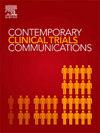THRIVE小组和同伴辅导促进危机稳定中心自杀康复的随机对照有效性试验研究方案
IF 1.4
Q4 MEDICINE, RESEARCH & EXPERIMENTAL
引用次数: 0
摘要
危机稳定中心(CSCs)提供了一个以人为本,以社区为基础的替代自杀预防急诊科。社区服务中心可为988预防自杀热线的人士提供社区内接受治疗的地方,以促进该热线的扩展。然而,新的、以康复为重点的自杀预防心理干预措施需要在csc中迅速实施才能有效。本初步研究考察了面向社会服务提供者的康复、希望、人际关系、价值观和参与(即茁壮成长)的可行性、可接受性和目标参与。THRIVE包括一个心理治疗小组和出院后的同伴康复辅导电话。该项目分为三个阶段,分别在csc中适应、试点和测试THRIVE,为全面的有效性试验做准备。在第一阶段,我们将使用实施设计和影响模型(即MADI)使THRIVE适应CSCs的实施需求(n = 25)。在第二阶段,我们将通过CSC利益相关者的反馈来评估THRIVE的可行性和可接受性,并在CSC客户(n = 20)中完成THRIVE的试点试验。在III期,我们将完成一项THRIVE的随机有效性试验(n = 162),以测试THRIVE在治疗开始时的有效性。我们还将研究THRIVE干预的目标参与(即受挫的归属感和感知负担)。参与者将被随机分配到(a)茁壮成长+放电;一如既往的安全计划(即干预臂);或(b)放电&安培;一如既往的安全规划(即控制臂)。参与者在基线、出院、1个月和3个月完成评估。该方案展示了将社区实践伙伴纳入研究的策略,并且是由国家精神卫生研究所(NIMH)赞助的CSC中的第一个随机对照试验。本文章由计算机程序翻译,如有差异,请以英文原文为准。
Study protocol for a randomized controlled effectiveness trial of THRIVE group and peer coaching to promote suicide recovery in crisis stabilization centers
Crisis Stabilization Centers (CSCs) offer a person-centered, community-based alternative to Emergency Departments for suicide prevention. CSCs may facilitate the expansion of the 988 Suicide Prevention Lifeline by providing callers with places to go in communities to receive treatment. However, new, recovery-focused psychological interventions for suicide prevention that can be rapidly implemented in CSCs are needed to be effective. This pilot study examines the feasibility, acceptability, and target engagement of the Toward Recovery, Hope, Interpersonal Connection, Values, and Engagement (i.e., THRIVE) for CSCs. THRIVE includes a psychotherapy group and peer-led recovery coaching calls after discharge. This project consists of three phases to adapt, pilot, and test THRIVE in CSCs in preparation for a full-scale effectiveness trial. In phase I, we will use the Model for Implementation Design and Impact (i.e., MADI) to adapt THRIVE to CSCs’ implementation needs (n = 25). In phase II, we will assess the feasibility and acceptability of THRIVE through CSC Stakeholder feedback and completing a pilot trial of THRIVE with CSC guests (n = 20). In phase III, we will complete a pilot randomized effectiveness trial of THRIVE (n = 162) to test the effectiveness of THRIVE on treatment initiation. We will also examine target engagement (i.e., as thwarted belongingness, and perceived burdensomeness) of the THRIVE intervention. Participants will be randomized to (a) Thrive + Discharge & Safety Planning as Usual (i.e., Intervention Arm): or (b) Discharge & Safety Planning as Usual (i.e., Control Arm). Participants complete assessments at baseline, discharge, 1 month, and 3 months. This protocol demonstrates strategies for involving community-based practice partners in research and is the first randomized controlled trial in a CSC sponsored by the National Institute of Mental Health (NIMH).
求助全文
通过发布文献求助,成功后即可免费获取论文全文。
去求助
来源期刊

Contemporary Clinical Trials Communications
Pharmacology, Toxicology and Pharmaceutics-Pharmacology
CiteScore
2.70
自引率
6.70%
发文量
146
审稿时长
20 weeks
期刊介绍:
Contemporary Clinical Trials Communications is an international peer reviewed open access journal that publishes articles pertaining to all aspects of clinical trials, including, but not limited to, design, conduct, analysis, regulation and ethics. Manuscripts submitted should appeal to a readership drawn from a wide range of disciplines including medicine, life science, pharmaceutical science, biostatistics, epidemiology, computer science, management science, behavioral science, and bioethics. Contemporary Clinical Trials Communications is unique in that it is outside the confines of disease specifications, and it strives to increase the transparency of medical research and reduce publication bias by publishing scientifically valid original research findings irrespective of their perceived importance, significance or impact. Both randomized and non-randomized trials are within the scope of the Journal. Some common topics include trial design rationale and methods, operational methodologies and challenges, and positive and negative trial results. In addition to original research, the Journal also welcomes other types of communications including, but are not limited to, methodology reviews, perspectives and discussions. Through timely dissemination of advances in clinical trials, the goal of Contemporary Clinical Trials Communications is to serve as a platform to enhance the communication and collaboration within the global clinical trials community that ultimately advances this field of research for the benefit of patients.
 求助内容:
求助内容: 应助结果提醒方式:
应助结果提醒方式:


